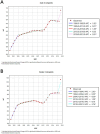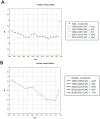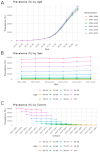Trends and forecasts of the prevalence and mortality of Alzheimer's disease and other dementias in China
- PMID: 40766032
- PMCID: PMC12322973
- DOI: 10.3389/fpubh.2025.1616232
Trends and forecasts of the prevalence and mortality of Alzheimer's disease and other dementias in China
Abstract
Background: As one of the most aging populations in the world, China has experienced a continuous increase in the disease burden of Alzheimer's Disease (AD) and other dementia (ADRD). This study aims to analyze the trends in prevalence and mortality rates of AD and related dementia in China from 1990 to 2021 and to predict the disease burden by 2040.
Methods: Data was extracted from the Global Burden of Disease Study 2021 (GBD 2021). Joinpoint regression was used to identify significant changes in trends, while Age-Period-Cohort (APC) models were applied to disentangle age, period, and cohort effects. Bayesian Age-Period-Cohort (BAPC) modeling was used for future projections. In addition, we conducted a risk factor analysis of AD-related mortality attributable to smoking, high body mass index (BMI), and high fasting plasma glucose (FPG).
Results: In 2021, the age-standardized prevalence of AD and other dementia in China was 1,194 per 100,000 (95% CI: 1018-1,383), and the mortality rate was 35 per 100,000 (95% CI: 9-93). The disease burden was significantly higher in females compared to males (prevalence: females 1,559 per 100,000 vs. males 846 per 100,000). Joinpoint analysis showed a significant increase in both prevalence and mortality rates after 2019 (male APC = 2.81%, female APC = 3.76%). Risk factor analysis highlighted obesity (AAPC = 9.87%) as the leading contributor to AD mortality in China, surpassing global averages. The BAPC model predicted that by 2040, the prevalence in females would increase to 1,180 per 100,000, while the mortality rate for males would stabilize at 17.6 per 100,000. Our results indicate a substantial increase in disease burden, underscoring the urgent need for strategic interventions and resource allocation to mitigate the future impact of dementia-related conditions in China.
Conclusion: The disease burden of AD and related dementia in China continues to rise, necessitating enhanced early screening, optimized healthcare resource allocation, and targeted intervention strategies for high-risk female populations.
Keywords: Alzheimer’s disease; China; dementia; mortality; prediction; prevalence.
Copyright © 2025 Hou and Yang.
Conflict of interest statement
The authors declare that the research was conducted in the absence of any commercial or financial relationships that could be construed as a potential conflict of interest.
Figures










Similar articles
-
The current status, trends, and challenges of Alzheimer's disease and other dementias in Asia (1990-2036).Front Public Health. 2025 Jun 10;13:1583339. doi: 10.3389/fpubh.2025.1583339. eCollection 2025. Front Public Health. 2025. PMID: 40556904 Free PMC article.
-
Trend analysis and future predictions of global burden of alzheimer's disease and other dementias: a study based on the global burden of disease database from 1990 to 2021.BMC Med. 2025 Jul 1;23(1):378. doi: 10.1186/s12916-025-04169-w. BMC Med. 2025. PMID: 40597083 Free PMC article.
-
Burden of knee osteoarthritis in China and globally: 1990-2045.BMC Musculoskelet Disord. 2025 Jul 1;26(1):582. doi: 10.1186/s12891-025-08858-8. BMC Musculoskelet Disord. 2025. PMID: 40598022 Free PMC article.
-
Plasma and cerebrospinal fluid amyloid beta for the diagnosis of Alzheimer's disease dementia and other dementias in people with mild cognitive impairment (MCI).Cochrane Database Syst Rev. 2014 Jun 10;2014(6):CD008782. doi: 10.1002/14651858.CD008782.pub4. Cochrane Database Syst Rev. 2014. PMID: 24913723 Free PMC article.
-
National and subnational burden of brain and central nervous system cancers in China and global from 1990 to 2021: results from the global burden of disease study 2021.Arch Public Health. 2025 Jul 28;83(1):195. doi: 10.1186/s13690-025-01683-4. Arch Public Health. 2025. PMID: 40722045 Free PMC article.
References
MeSH terms
LinkOut - more resources
Full Text Sources
Medical
Research Materials

